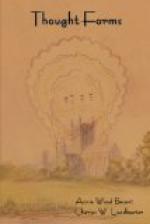Wagner.—No one who has devoted any study to these musical forms would hesitate in ascribing the marvellous mountain-range depicted in Plate W to the genius of Richard Wagner, for no other composer has yet built sound edifices with such power and decision. In this case we have a vast bell-shaped erection, fully nine hundred feet in height, and but little less in diameter at the bottom, floating in the air above the church out of which it has arisen. It is hollow, like Gounod’s form, but, unlike that, it is open at the bottom. The resemblance to the successively retreating ramparts of a mountain is almost perfect, and it is heightened by the billowy masses of cloud which roll between the crags and give the effect of perspective. No attempt has been made in this drawing to show the effect of single notes or single chords; each range of mimic rocks represents in size, shape, and colour only the general effect of one of the sections of the piece of music as seen from a distance. But it must be understood that in reality both this and the form given in Plate G are as full of minute details as that depicted in Plate M, and that all these magnificent masses of colour are built up of many comparatively small bands which would not be separately visible upon the scale on which this is drawn. The broad result is that each mountain-peak has its own brilliant hue, just as it is seen in the illustration—a splendid splash of vivid colour, glowing with the glory of its own living light, spreading its resplendent radiance over all the country round. Yet in each of these masses of colour other colours are constantly flickering, as they do over the surface of molten metal, so that the coruscations and scintillations of these wondrous astral edifices are far beyond the power of any physical words to describe.
[Illustration: PLATE W. MUSIC OF WAGNER]
A striking feature in this form is the radical difference between the two types of music which occur in it, one producing the angular rocky masses, and the other the rounded billowy clouds which lie between them. Other motifs are shown by the broad bands of blue and rose and green which appear at the base of the bell, and the meandering lines of white and yellow which quiver across them are probably produced by a rippling arpeggio accompaniment.
In these three Plates only the form created directly by the sound-vibrations has been drawn, though as seen by the clairvoyant it is usually surrounded by many other minor forms, the result of the personal feelings of the performer or of the emotions aroused among the audience by the music. To recapitulate briefly: in Plate M we have a small and comparatively simple form pourtrayed in considerable detail, something of the effect of each note being given; in Plate G we have a more elaborate form of very different character delineated with less detail, since no attempt is made to render the separate notes, but only to show how each chord expresses itself in form and colour; in Plate W we have a still greater and richer form, in the depiction of which all detail is avoided, in order that the full effect of the piece as a whole may be approximately given.




